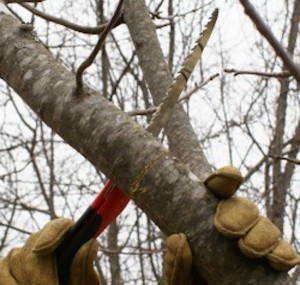Expert: Tree care important in fall and winter months
Chronicle Media — November 19, 2015
Pruning trees in the fall can encourages new growth, but waiting too long into the winter can cause difficulties for the gardener and the tree, according to horticulture educators. (Photo University of Maine Extension)
When the cool weather of late fall arrives, the desire to work outdoors is enticing. The heat and humidity of summer are past, and the changing colors of leaves are pleasing and relaxing.
The impulse to clean up plants and make sure that the gardens are put to bed before snowfall can be strong, and often people pull out pruning tools and begin to prune trees too late in the season, said University of Illinois Extension horticulture educator Kari Houle.
Pruning trees in late summer and fall encourages new growth that won’t have time to harden off before winter arrives. “Hardening off” means that the plants have time to prepare for the coming freeze.
“The only reason that pruning should occur in the fall is to remove dead or damaged branches to minimize stress on the tree,” she said.”The best time to prune trees is during the dormant season. If you don’t end up having time to prune trees during the dormant season, avoid pruning right after trees leaf out in the spring,” Houle said.
Another good habit to get into regarding fall and winter tree care is to provide adequate soil moisture.
“Reducing irrigation in fall can cause stress on trees, and it’s best to keep soil moist as long as the ground isn’t frozen as roots will still pull moisture up,” Houle said. “By providing supplemental irrigation, you reduce stress on the tree through the winter. This is especially important for evergreens as they can suffer from winter desiccation, which is loss of moisture from intense winter winds and sun.”
Making sure to properly mulch trees helps to also reduce ground temperature fluctuations as well as to assist in maintaining soil moisture. Houle recommends organic-based mulches. “Apply mulch 2 to 4 inches deep and maintain a 2-inch gap between the tree trunk and mulch,” Houle said
For many years, it was recommended to wrap newly planted trees or thin bark trees to protect them from sunscald over the winter. Houle said that research has shown that tree wraps do not help to minimize temperature fluctuations but can in fact increase the temperature extremes on the trunk of the tree.
“Tree wraps can also be a perfect place for insects and disease to take up residence,” she said. “If you do need to wrap the trunk of the tree to protect it from animals such as deer, then abstain from use. If using tree wraps for protection, then make sure to use light-colored wraps and wait until as late as possible, removing the wrap early in the spring.”
Kari Houle is a horticulture educator with the University of Illinois Extension
—Expert: Tree care important in fall and winter months—



